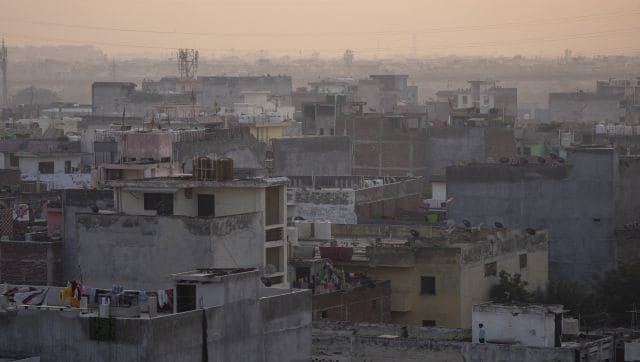Explainers
Explained: How Cyclone Sitrang helped Delhi record its cleanest post-Diwali air since 2015
A day after Diwali, Delhi recorded an AQI of 303, the lowest since 2015. Cyclone Sitrang’s strong winds crossing towards Bangladesh enabled the dispersal of pollutants, reducing the overall air pollution in the national capital
FP Explainers Last Updated:October 26, 2022 10:39:19 IST 
A man stands on a terrace of a building as morning haze envelops the skyline in New Delhi. AP
Delhi’s air quality slipped to ‘very poor’ on Tuesday, a day after Diwali as Delhiites ignored the ban and celebrated the festival by setting off firecrackers across the Capital and NCR region.
As per data provided by the Central Pollution Control Board (CPCB), the AQI one day after Diwali (Tuesday) was 323 at 6.30 am. The 24-hour average AQI at 4 pm on Tuesday stood at 303, the lowest for the day after Diwali since 2015.
Graphic: Pranay Bhardwaj
An AQI between zero and 50 is considered good, 51 and 100 satisfactory, 101 and 200 moderate, 201 and 300 poor, 301 and 400 very poor, and 401 and 500 severe.
Related Articles
In graphics | Why is Delhi’s air quality declining once again?
Delhiites have seen 200 ‘good air’ days so far in 2023
Delhi Chief Minister Arvind Kejriwal said the air levels had improved and it was the results of efforts made by Delhi residents to curb pollution in the city. However, he added that while the outcome was encouraging there was still a long way to go.
On Wednesday morning, Delhi’s air became a bit easier to breathe as the AQI moved from the ‘very poor’ category to the ‘poor’ category — the AQI stood at 262 at 6 am.
While Chief Minister Kejriwal credited residents of the Capital for their fight against pollution, experts cite that there were multiple meteorological conditions that played a role in the improved air quality this time. And one of the biggest factors was Cyclone Sitrang.
Cyclone Sitrang and the dirty air
According to experts, the movement of Cyclone Sitrang towards Bangladesh helped in clearing Diwali pollution over Delhi-NCR. Experts observed that since Cyclone Sitrang moved away from the northern plains of India, it pulled winds and moisture towards it. This led to moderately strong westerly wind flows and dry conditions, both of which enabled dispersal of pollutants.
India Meteorological Department (IMD) chief Mrutyunjay Mohapatra explained that when Sitrang moved towards Bangladesh, winds from north India moved in that direction. Therefore, it exacerbated the air flow in north India. It also drained out moisture from the region.
Mohapatra said that a deep trough in the mid and upper atmosphere over east Uttar Pradesh also reinforced the westerly wind flows in the region.
Mohapatra was quoted as saying to Times of India, “Had the cyclone hit the Odisha coast and moved northwestward towards Chhattisgarh, the situation in north India would have been very different. A cyclone moving towards the region would have led to an incursion of moist, easterly winds which would have led to cloudy skies. Under such conditions, pollution levels may have shot up.”
Former IMD scientist DS Pai echoed similar sentiments, attributing the cyclone for lower pollution levels in Delhi. He explained the pollution did not stay because after the remnant of the cyclone moved towards northeast India and the northwesterly winds strengthened.
Private forecaster Skymet Weather Services vice president (climate change and meteorology) Mahesh Palawat also noted the same that the pollution build-up wasn’t too high and that Sitrang’s strong winds moved it away from over Delhi.
Incidentally, it wasn’t just Delhi-NCR that benefited from Cyclone Sitrang. News agency IANS had reported that Cyclone Sitrang had also brought down pollution levels on Kali Puja night of Monday and the morning after in Kolkata.
Other factors at play
While Cyclone Sitrang was a major factor in bringing down pollution levels in Delhi a day after Diwali, there were other reasons too at play.
A delay in peak stubble burning incidents and also that Diwali fell in October when temperatures are warmer helped control air pollution, according to Vijay Kumar Soni, head of the environment monitoring and research centre at the IMD.
Data released by Consortium for Research on Agroecosystem Monitoring and Modeling from Space (CREAMS) — an initiative of the Indian Agricultural Research Institute — reveals that the country recorded 1,519 instances of stubble burning on the day of Diwali. This is far lower than the 3,525 fires that were detected last year on the same day.
Another factor that needs to be considered is the delayed withdrawal of monsoon from northwest India. Delhi and surrounding areas witnessed widespread rain in early October, which washed out accumulated air pollution. This ensured that the build-up of pollutants was not high.
Moreover, measures under the Graded Response Action Plan (GRAP) also kicked in earlier than previous years — actions such as mechanical and vacuum-based sweeping of roads, stopping the use of diesel generator sets had already been implemented.
How other cities fared
While Delhi recorded a ‘very poor’ AQI a day after Diwali, it wasn’t the only city suffering from air pollution. In Mumbai, the country’s financial capital, most stations were in the “moderate category” with the AQI below 200. However, the air quality was in the “poor category” with AQI above 200 at Malad West and Deonar stations.
In Chennai, most weather stations recorded AQI in the “poor” category. In Bengaluru, the AQI ranged between “moderate” and “satisfactory”. The AQI stood in the “poor” category at the Silkboard monitoring station.
Kolkata had a different story to share. Most monitoring stations recorded an AQI in the ‘good’ category.
With inputs from agencies
Read all the Latest News, Trending News, Cricket News, Bollywood News,India News and Entertainment News here. Follow us on Facebook, Twitter and Instagram.



